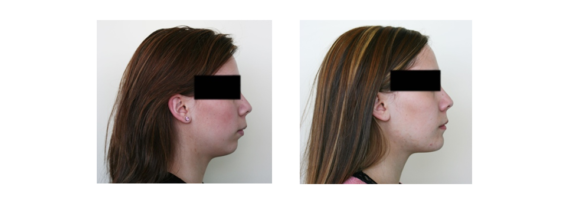La chirurgie maxillo-faciale
Complément technique
Pourquoi ?
La chirurgie maxillo-faciale ou chirurgie des mâchoires peut être parfois indispensable dans certaine dysmorphose maxillo-faciale.
Elle a pour but de rétablir un équilibre squelettique dans les 3 dimensions de l’espace afin d’obtenir :
Projection du menton : si votre menton se situe trop en arrière, il se peut alors que votre mâchoire inférieure soit sous-développée par rapport à la mâchoire supérieure ; n’ayant plus de croissance et le décalage étant trop important pour le rattraper par l’inclinaison des dents, la seule solution est de repositionner les mâchoires dans une relation plus harmonieuse, par le biais d’une chirurgie maxillo-faciale, réalisée par un chirurgien maxillo-facial.

Le menton peut également se trouver trop en avant, la chirurgie peut également pallier ce problème.
Diminution de la projection des incisives :
Si vous avez l’impression que vos dents supérieures sont trop en avant et que vous avez du mal à fermer la bouche, c’est souvent la mâchoire inférieure qui se situe trop en arrière. La chirurgie des mâchoires permet de rétablir une occlusion fonctionnelle mais également une compétence labiale.
Raccourcissement du traitement orthodontique :
Le fait de réaliser une chirurgie maxillo-faciale entraîne souvent une diminution du temps de traitement global. En effet, le décalage des mâchoires est complètement corrigé par la chirurgie, il suffit ensuite de bien emboîter les dents du haut avec celle du bas.
Harmonisation du sourire :
La chirurgie maxillo-faciale, permet d’améliorer le sourire, en l’élargissant ou en découvrant plus ou moins la gencive.
Il est souvent nécessaire d’intervenir sur la mâchoire du haut et celle du bas. Il s’agit d’une chirurgie dite « bimaxillaire ».
Amélioration du contexte fonctionnel :
Les dysharmonies squelettiques s’accompagnent souvent de dysfonctions notamment :
– une dysfonction linguale : la rééducation auprès d’un orthophoniste ou d’un kinésithérapeute spécialisé est primordial pendant le traitement orthodontique, et encore plus après la chirurgie où tout le contexte facial est réorganisé.
– une ventilation buccale, associée ou non à un SAHOS (apnée du sommeil), vous serez adressé à un médecin du sommeil (ORL, pneumologue) pour un bilan du sommeil avant le traitement orthodontique, de façon à dépister un éventuel SAHOS.
Comment ?
La chirurgie est réalisée par un chirurgien maxillo-facial
Vous verrez le chirurgien maxillo-facial en consultation avant le début du traitement orthodontique, afin d’évaluer la nécessité d’un traitement orthodontico-chirurgical.
Vous êtes opérés avec votre appareil orthodontique en bouche.
La phase de décompensation orthodontique :
L’appareil orthodontique est posé afin de « décompenser » l’occlusion. C’est la préparation orthodontique : il se peut que le décalage esthétique s’accentue durant cette phase.
Lorsque nous estimons que vous êtes prêts pour la chirurgie (souvent au bout d’un an), vous revoyez le chirurgien maxillofacial avec des radiographies pour prévisualiser l’intervention.
Quelques jours avant la chirurgie, l’orthodontiste doit mettre en place des crochets sur l’appareil ou des boutons sur les dents afin de placer les élastiques entre la mâchoire du haut et celle du bas. Les élastiques sont placés juste après l’intervention pour maintenir les mâchoires et les dents dans la bonne position.
La phase orthodontique post-chirurgicale :
la chirurgie a été réalisée ; il faut maintenant stabiliser la nouvelle occlusion. Les élastiques prennent alors toute leur importance. Cette phase de finition orthodontique dure en général un an.
Après la dépose de l’appareil orthodontique une phase de contention est indispensable pour maintenir les résultats obtenus.
Quelles sont les suites post-opératoires ?
- La chirurgie entraîne un œdème des tissus faciaux, se traduisant par un gonflement du visage.
- La douleur est modérée, elle cède avec des antalgiques prescrit par le chirurgien maxillo-facial et disparaît au bout de quelques jours
- Vous aurez des élastiques immédiatement après la chirurgie, permettant une stabilisation de la chirurgie ; une alimentation semi liquide est à prévoir les premiers jours.
- Une perte de sensibilité concernant le menton et les lèvres peu apparaître, elle est transitoire.
